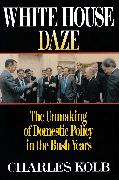- Start
- White House Daze
White House Daze
Angebote / Angebote:
What happened to 'We are the Change' between 1988 and 1992? The answer to that question explains why George Bush was a one-term President.
The Party of new ideas had become the party of incumbency. Many Republicans now took for granted the "electoral lock", the Southern bloc, and Republican control of the executive branch. Their complacency was reinforced by the President's own high approval ratings through the first half of his term. Yet it's fair to say that for the first two years of the Bush Administration we were still spending down Ronald Reagan's inheritance. Even though the actual policies being implemented in many respects were really at odds with Reagan's core philosophy, the country had not woken up to the fact that under George Bush's stewardship federal spending (along with the deficit) was spiralling upward, taxes would start creeping up again, and regulatory policies would impose billions of dollars of new burdens on the public. This was 'change', allright, but the wrong kind of change...
The cumulative effect of these deviations from Reaganism, combined with the disastrous 1990 budget deal, split the Republican national coalition and contributed to the lingering recession that began in mid-1990...
Many things that Americans had long taken for granted were now changing rapidly, some in ways that would mean a stronger nation, others in ways that the public found unsettling. The country needed sound leadership that was capable of doing two essential things: explaining why the changes were happening and charting a future course to address them.
What the American public got from us instead was slavish adherence to the status quo and an unwillingness or inability to explain all the major developments in a context that Americans could fathom. The country saw its sixty-eight-year-old President traveling the land expressing his own bewilderment and calling 1992 'weird, weird, man'. And 'weird' was not what people wanted or needed t
Folgt in ca. 10 Arbeitstagen
